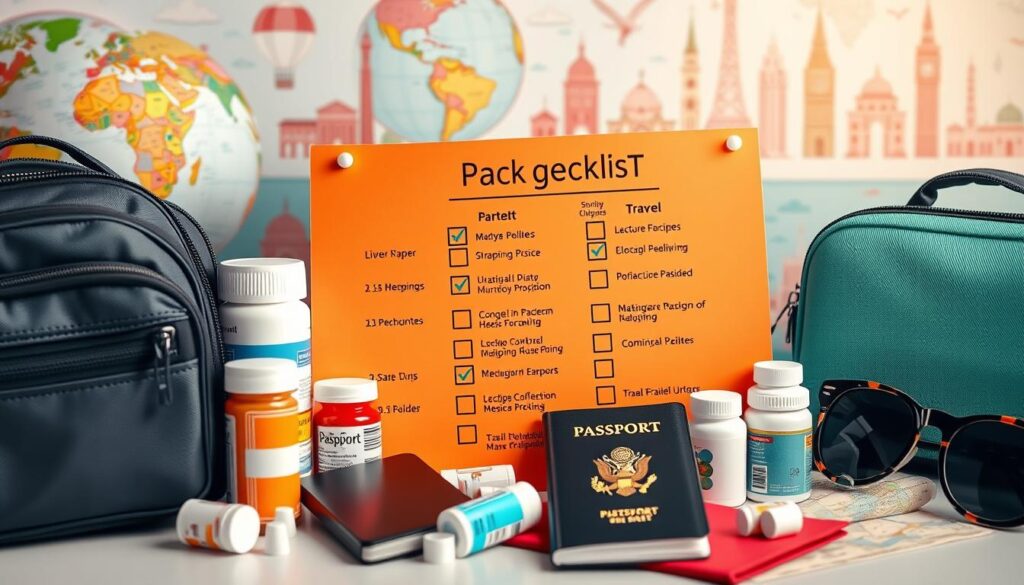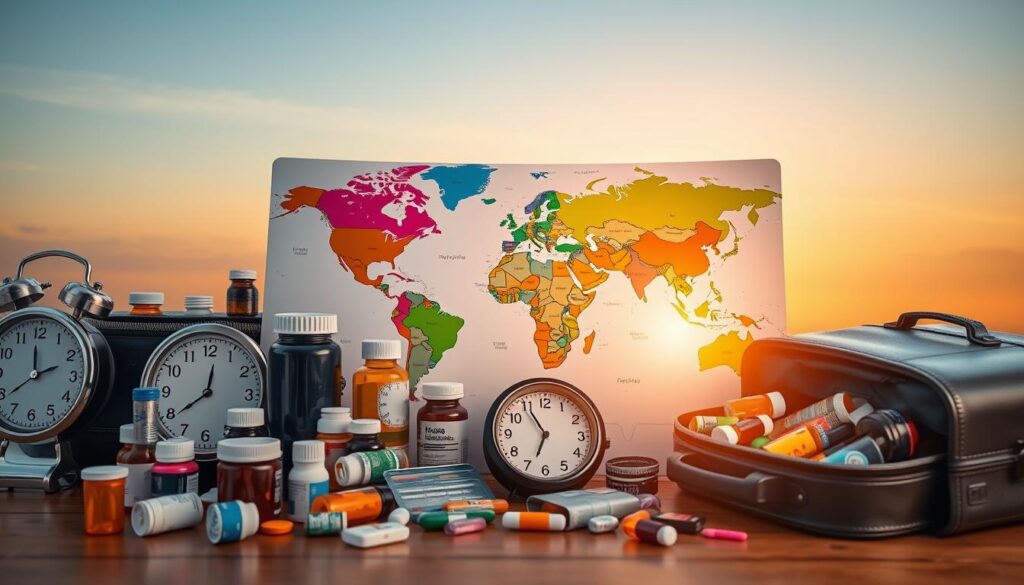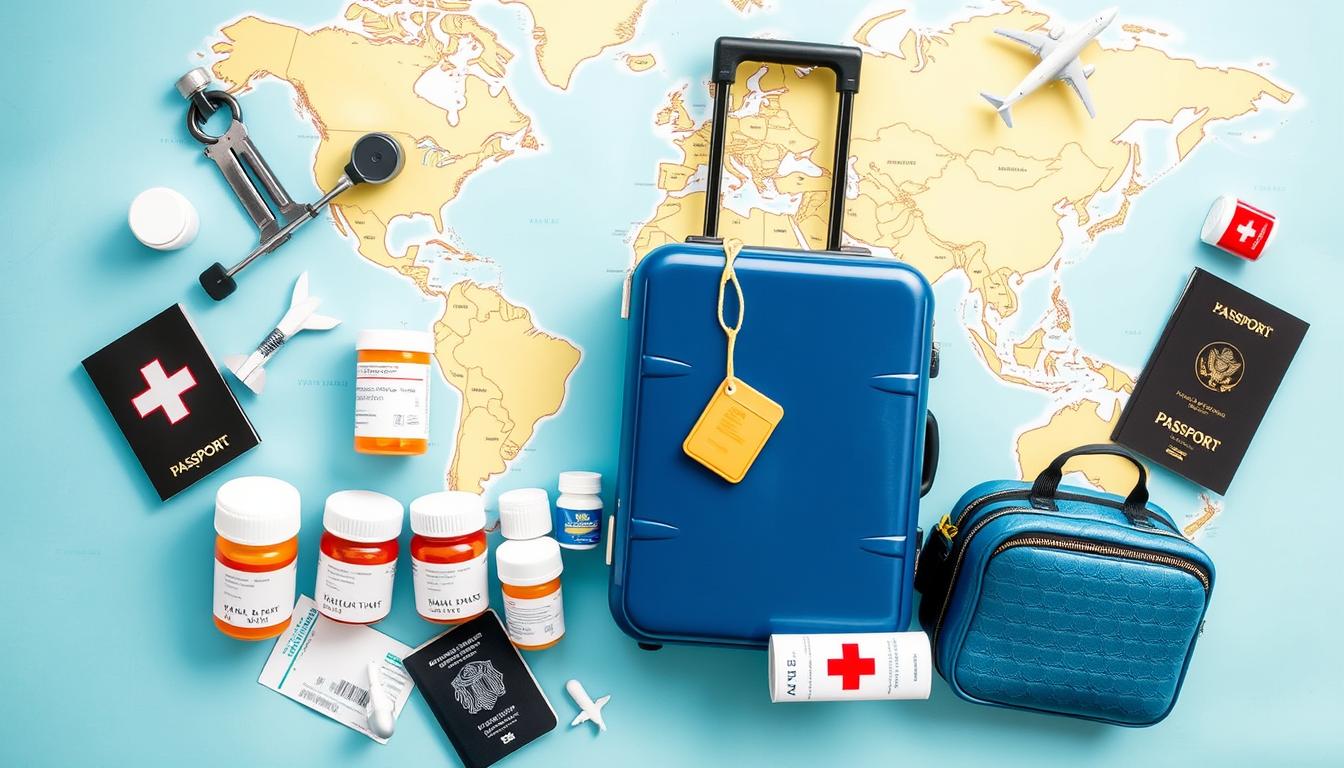Planning a trip? Don’t forget about your meds! Traveling with medication can be tricky. But it’s crucial for your health and well-being. This guide covers the key travel medication rules and offers helpful tips for a smooth journey.
Whether you’re jetting off for a quick weekend getaway or embarking on a long-term adventure, knowing how to pack and transport your prescriptions is vital. We’ll walk you through the essential steps to keep your medications safe and accessible throughout your travels.
From understanding airline regulations to properly storing your meds, we’ve got you covered. Our guide aims to simplify the process of traveling with medication. So, you can focus on enjoying your trip without worrying about your health needs.
Key Takeaways
- Familiarize yourself with TSA and international travel medication rules
- Keep medications in original packaging with clear labels
- Bring a copy of your prescription and a doctor’s note
- Pack medications in your carry-on bag for easy access
- Research country-specific regulations for international travel
- Plan for time zone changes and medication schedules
- Have a backup plan for lost or stolen medications
Understanding Basic Medication Travel Regulations
It’s key to know how to travel with medicine for a smooth trip. Each country has its own rules for medicine, so learn them before you go.
TSA Medication Guidelines
The TSA lets you carry medicine in both carry-on and checked bags. Liquids over 3.4 ounces are okay but tell security about them. Keep your medicines in their original containers to pass security checks.
International Travel Rules
When going abroad, check the medicine laws of your destination. Some places ban medicines allowed in the U.S. Carry a doctor’s letter explaining your medicine and dosage.
Controlled Substance Regulations
Traveling with controlled substances needs extra care. These medicines have strict rules at home and abroad. You might need a special permit or doctor’s note to take them across borders.
| Medication Type | Domestic Travel | International Travel |
|---|---|---|
| Over-the-counter | Generally allowed | Check country-specific rules |
| Prescription | Allowed with proper labeling | May require doctor’s letter |
| Controlled substances | Strict regulations apply | Special permits often required |
Knowing these basics helps you follow travel rules and avoid trip problems.
How to Travel with Medication Safely and Legally
Traveling with prescription drugs needs careful planning. You must follow international travel rules. Here are steps for a smooth trip:
Pack your meds in their original containers. Make sure they have clear labels. This helps airport security know they’re yours. Also, carry a copy of your prescriptions and a doctor’s letter about your health.
Find out the rules for bringing meds to your destination. Some places have strict rules on certain drugs. Check with your country’s embassy or consulate for details.
- Carry medications in your carry-on bag to prevent loss or theft
- Bring enough medication for your entire trip, plus extra in case of delays
- Keep a list of all your medications, including generic names and dosages
When going through security, tell them about your meds. TSA lets you bring liquid meds over 3.4 ounces if they’re for your health. Be ready to show your prescriptions if asked.
“Always research medication laws for your destination. What’s legal at home might be restricted abroad.”
By following these tips, you can travel safely with your meds. Remember, being prepared is the best way to avoid problems when traveling with prescription drugs.
Essential Documentation for Traveling with Prescription Drugs
When you travel with medicine, you need the right papers. This makes your trip smooth and follows the rules. Let’s look at the important documents you should have.
Prescription Labels and Documentation
Keep your medicines in their original bags. Make sure the labels are clear and easy to read. They should show your name, the doctor’s name, and how much to take.
Also, pack a copy of your prescription or a list from your doctor.
Doctor’s Letters and Medical Certificates
Bring a letter from your doctor. It should explain why you need your medicines. List all your medicines, their names, and how much you take.
Some places need a medical certificate, like for special medicines or shots.
Translation Requirements for International Travel
If you’re going to a place where they don’t speak English, translate your papers. This includes labels, doctor’s letters, and certificates. Translations help avoid problems with officials or doctors.
| Document | Purpose | Required for |
|---|---|---|
| Prescription Label | Identifies medication and dosage | All prescription drugs |
| Doctor’s Letter | Explains medical necessity | Controlled substances, injectable medicines |
| Medical Certificate | Confirms diagnosis and treatment | International travel, certain medications |
| Translated Documents | Ensures understanding in foreign countries | Travel to non-English speaking destinations |
Remember, the right papers are important when you travel with medicines. Always check what you need for your trip. Get your papers ready early.
Proper Medication Storage During Travel
Keeping medicines safe while traveling is very important. Travel rules for medicines need careful planning and storage. Let’s look at good ways to keep your medicines safe on the move.
Temperature Control Solutions
Many medicines need a certain temperature to work right. Using a medication cooler is a smart move for these drugs. These coolers keep the temperature steady, keeping your medicines safe from too much heat or cold.
Protecting Medications from Environmental Factors
Moisture, light, and air can harm some medicines. Keep pills in tight, dark containers to protect them. For liquid medicines, wrap bottles in bubble wrap to stop them from breaking or leaking while you’re moving.
Using Travel Medication Containers
Travel-sized containers for medicines are handy and organized. Pick ones with different spots for different medicines and times. This makes it easy to keep up with your medicine schedule, even when you cross time zones.
- Use waterproof containers for extra safety
- Write the name and dosage of each medicine on the container
- Carry an extra empty container for any extra travel
By using these storage tips and following travel medicine rules, you can keep your medicines safe and working well on your trip.
Airport Security Screening Procedures for Medications
It’s important to know how to travel with medication through airport security. When you get to the checkpoint, tell the TSA officer you have medications. This makes the screening process easier.
Most medications can go through X-ray machines without problems. If you don’t want your medications X-rayed, ask for a visual check. The TSA officer will look at your medications and might test for explosives.
Keep your medications in their original containers. This makes it easier to identify them and speeds up the screening. If you use pill organizers, bring the original bottles too.
- Declare all liquid medications
- Remove medications from your carry-on for separate screening
- Be prepared to open containers if asked
For injectable medications or supplies like syringes, tell the TSA officer before screening. These items might need extra checks. You can also bring ice packs, freezer packs, or gel packs to keep medications cool.
By knowing these steps, you’ll go through airport security easily. Make sure your medications are handled right. Always check the latest TSA guidelines before your trip, as rules can change.
Planning Ahead: Pre-Travel Medication Checklist
Getting ready for travel with meds needs careful planning. A good checklist helps you pack right. Here are key tips for packing and preparing your meds.
Calculating Medication Quantities
When packing meds, bring enough for your whole trip plus extra. A good rule is to pack 50% more than you think you’ll need. This way, you’re ready for any unexpected delays or lost doses.

Backup Prescription Plans
Always have a backup plan for your meds. Carry a copy of your prescriptions and your doctor’s contact info. Some people ask their doctor for an extra prescription to fill at their destination if needed.
Emergency Contact Information
Make a list of emergency contacts, like your doctor, pharmacy, and insurance. Keep this list in your phone, wallet, and luggage. It’s smart to look up pharmacies at your destination too, in case you need to refill.
- Pack 50% more medication than needed
- Carry copies of prescriptions
- List emergency contacts
- Research local pharmacies at your destination
Follow these tips and make a detailed checklist. This way, you’ll be ready for your trip. Remember, good planning is key to keeping your health safe while traveling.
Special Considerations for Different Types of Medications
Traveling with prescription drugs needs careful planning. Knowing the rules for different medicines is important. We’ll look at special tips for liquid, injectable, and temperature-sensitive drugs.
Liquid Medications
Liquid medicines get checked at security. TSA lets you carry liquids over 3.4 ounces if they’re reasonable. Put them in a clear, quart-sized bag and tell security.
Bring a doctor’s note to explain why you need the liquid medicine. This helps avoid problems.
Injectable Medicines
When you travel with injectable medicines, keeping them cool is important. Use insulated bags to keep the right temperature. Carry syringes and needles in their original containers.
A doctor’s letter is key. It explains why you need these items when you travel.
Temperature-Sensitive Drugs
Some medicines need a certain temperature to work right. Use insulated bags or cooling packs for these. Check with your airline about using refrigerators on the plane.
Plan how to keep your medicine cool at your destination. This is very important in hot places.
| Medication Type | Storage Requirement | Travel Tip |
|---|---|---|
| Liquid | Room temperature | Clear bag, declare at security |
| Injectable | Insulated case | Original containers, doctor’s note |
| Temperature-sensitive | Specific temperature range | Cooling packs, insulated container |
Every type of medicine has its own travel rules. Always check the latest rules and talk to your doctor before traveling with medicines.
International Travel Restrictions and Country-Specific Rules
Traveling with medicines abroad needs careful planning. Each country has its own rules for medicines. It’s important to know these rules before you pack your medicines.
Medicine rules change from country to country. Some places ban medicines that are okay in the US. Others have limits or need special papers. Not following these rules can cause problems with your medicines.
To deal with these issues, start by checking your destination’s embassy website. Look for info on bringing medicines. If you can’t find clear answers, call the embassy.
| Country | Common Medication Restrictions | Required Documentation |
|---|---|---|
| Japan | Strict limits on psychotropic medications | Yakkan Shoumei form for quantities exceeding a month’s supply |
| United Arab Emirates | Bans many common prescription drugs | Doctor’s letter and prescription copy required |
| Russia | Restricts narcotic and psychotropic substances | Notarized Russian translation of prescription |
Remember, medicine rules can change. Always check the latest rules before you go. Knowing and following these guidelines helps you travel smoothly with your medicines.
Managing Time Zones and Medication Schedules
Traveling across time zones can mess up your medication routine. It’s important to plan well to stay healthy while seeing new places. Here are some tips for managing your meds while traveling.
Adjusting Medication Timing
When you travel to a new time zone, slowly change your medication schedule. Start changing a few days early to avoid bad side effects. For short trips, you might stick to your home schedule to avoid getting mixed up.

Creating a Travel Medication Schedule
Make a special schedule for your meds on the trip. Write down all your meds, how much, and when to take them. This includes both prescription and over-the-counter drugs. This plan is a quick guide and helps you remember to take your meds.
Using Medication Reminder Apps
Use apps to make managing your meds easy. Many apps help travelers remember to take their meds. They send reminders, adjust for time zone changes, and keep track of your doses. Some popular ones are Medisafe, Mango Health, and MyTherapy.
Being consistent with your meds is very important. By using these tips, you’ll make sure you take the right amount at the right time, anywhere you go. Learning how to travel with meds can make your trips easier and less stressful.
Emergency Situations: Lost or Stolen Medications
Traveling with medications needs careful planning. But, emergencies can still occur. It’s important to know how to handle lost or stolen meds. This ensures your health stays a top priority.
Emergency Pharmacy Access
If you lose your meds, find a nearby pharmacy fast. Many cities have 24-hour pharmacies. Show your prescription or explain your needs.
Some pharmacies need a local doctor’s prescription. So, check travel medication rules for your destination first.
Insurance Coverage Abroad
Check your insurance before you travel. Some plans cover emergency prescription refills abroad. Keep your insurance card ready and know how to file claims.
Think about getting travel insurance for extra protection.
Embassy Assistance Options
U.S. embassies can help in medication emergencies. They can:
- Recommend local English-speaking doctors
- Help contact your family or friends
- Assist in transferring funds for medical care
| Emergency Resource | Services Provided |
|---|---|
| Local Pharmacies | Medication refills, over-the-counter alternatives |
| Travel Insurance | Emergency medical coverage, prescription reimbursement |
| U.S. Embassy | Medical referrals, communication assistance, financial aid |
Prevention is the best way. Always pack extra meds. Keep a copy of your prescriptions separate from your main supply. This helps avoid emergencies and follows travel medication rules.
Tips for Cruise Ship and Extended Travel
Cruise ships and long trips need special tips for meds. On a cruise, talk to the onboard doctor about your meds. They can help with storage and refills. Pack extra meds in case of delays. For extended travel, plan ahead for refills in different ports.
Storage is key when you travel with medication on a ship. Keep your meds in a cool, dry place in your cabin. Some ships offer mini-fridges for temperature-sensitive drugs. Ask the crew about this option before you sail. Remember to bring your meds in their original bottles with clear labels.
For both cruise and long trips, create a detailed list of your medications. Include dosages and schedules. This helps if you need medical care away from home. It’s smart to pack a complete travel kit with all your health needs. This includes your meds, copies of prescriptions, and a letter from your doctor.
Lastly, check your travel insurance. Make sure it covers medication replacement if needed. Some policies help with emergency refills or doctor visits in foreign ports. Being prepared makes managing your health easier, letting you enjoy your trip worry-free.


